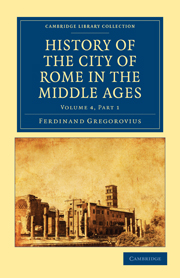CHAPTER V
Published online by Cambridge University Press: 05 October 2010
Summary
Death of Alexander II., April 21, 1073
Alexander II. died on April 21, 1073, and was succeeded by Hildebrand. In this man of com manding genius the stern and magnificent spirit of the ancient Romans seemed reincarnate. He stood on the boundaries of two social periods; one order was passing away, another had but dawned. Hildebrand was essentially a politician, not a churchman, and he seemed but little fitted to wear the priestly robe. His importance consisted in the fact that he remodelled the hitherto existing relations of the Church to the world and the temporal power by one of the most violent revolutions known to history. He was the Cæsar of papal Rome: the sole rule of the Papacy the object of his policy.
Hildebrand
Hildebrand was by birth, however, neither a Roman nor a Latin. His father Bonizo is said to have been a poor joiner of the Tuscan Soana, and the greatest pope of Rome belonged to the Lombard race, which so largely populated Tuscany. Hildebrand had come to Rome when a boy under the protection of an uncle, Abbot of S. Maria on the Aventine. There he may have taken the Benedictine cowl, for he became a monk, and afterwards entered the order of Cluny; and it is in his genius that the hierarchical ideas of this order took an all-dominant form.
- Type
- Chapter
- Information
- History of the City of Rome in the Middle Ages , pp. 167 - 222Publisher: Cambridge University PressPrint publication year: 2010First published in: 1896

